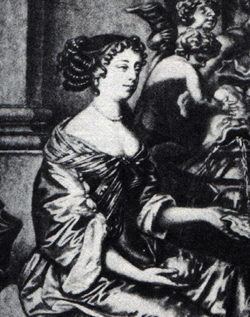Name Mary Saunderson Role Singer | Died 1712 | |
 | ||
Mary Saunderson (1637–1712), later known as Mary Saunderson Betterton after her marriage to Thomas Betterton, was an actress and singer in England during the 1660s and 1690s. She is considered one of the first English actresses.
Contents

Stage career
Her most notable accomplishments are her being the first female actress to portray several of Shakespeare's woman characters on the professional stage. She was the first to portray Juliet in Romeo and Juliet, Lady Macbeth in Macbeth, and other female roles in The Tempest, Hamlet (as Ophelia), Measure for Measure, Much Ado About Nothing, Twelfth Night, King Lear. In Shakespeare's day, female roles were played by teenage boys, as women and young girls were not allowed on the stage. By the 1660s, however, the laws in England had changed, allowing females to act professionally. Mary's connections through her husband, Thomas, who was also a famous actor, allowed her to play several significant roles. Saunderson had a reputation for virtue; Colley Cibber described her as leading "an unblemish'd and sober life".
One of her earliest roles was in The Siege of Rhodes, taking over the role of Ianthe in place of a Mrs. Edward Coleman, whom many agreed had done very poorly in the role. Acting under the direction of William Davenant, Mary did very well, even to the point that she was frequently called Ianthe for the rest of her life. She sang in several of Aphra Behn's operas. Perhaps her greatest and most lauded accomplishment was her performance in the role of Lady Macbeth. Actor-playwright Colley Cibber considered her “so great a Mistress of Nature” who was the only actress able to “throw out those quick and careless Strokes of Terror from the Disorder of a guilty Mind … with a Facility in her Manner that render'd them at once tremendous and delightful”. She played the major female roles for about 30 years, until she gradually faded out of the stage lights in the early 1690s. Her final appearance was in John Dryden's last play, Love Triumphant, where she played the leading female role.
Teaching career
As acting was one of Betterton’s most beloved passions, she also had the desire to put forth her talents as a way of educating and influencing the young minds around her. Mary Betterton and her husband even informally adopted actress, Anne Bracegirdle, and played a key role in prepping her for the very successful and popular stage career that she would have. Bracegirdle was also known as, “the celebrated virgin,” meaning that she was popular for not being the risqué stereotype that came with many actresses during this time. The “celebrated virgin” label that Bracegirdle received was easily attributed to the moral teachings that Betterton also provided when training the young actress. Mary Betterton was such a positive light and educator to young actresses that King Charles II requested her as his first choice to train his nieces (daughters of his younger brother) to become great actresses, which is a huge reflection of how respected she was as an acting coach and mentor. As Lady Anne and Lady Mary grew up to be Queens, the work of Betterton could be seen in their speeches with their “clear and direct voices”. Betterton had a lasting impact on these women, so much so that when Thomas Betterton died, Queen Anne granted her a yearly pension to ensure that she was taken care of financially.
Personal life
Mary Betterton is a descendant (Grandaughter) of Richard Burbage, one of William Shakespeares men, one of the first and most famous shakespearian actors. Very little or if anything is known of her childhood. The first information that can be found of her is that Sir William Davenant hired her to perform for the Duke’s company in 1661. She lived with others in the company under his wife’s care until she and the leading man of the company, Thomas Betterton, obtained a marriage license on Christmas Eve in 1662. Their marriage lasted for some 48 years under “the strictest amity” until her husband’s death in 1710. Mrs. Betterton was different than many other English actresses, in that she attracted no public chatter or gossip about her personal life; she was simply not interested in enticing any foolish blather about her life off stage.
